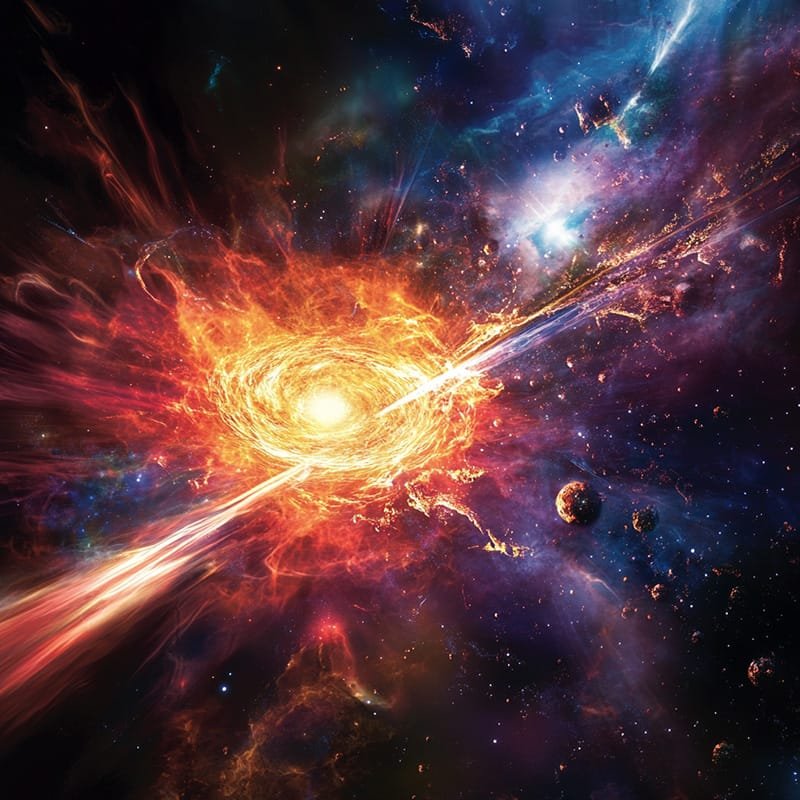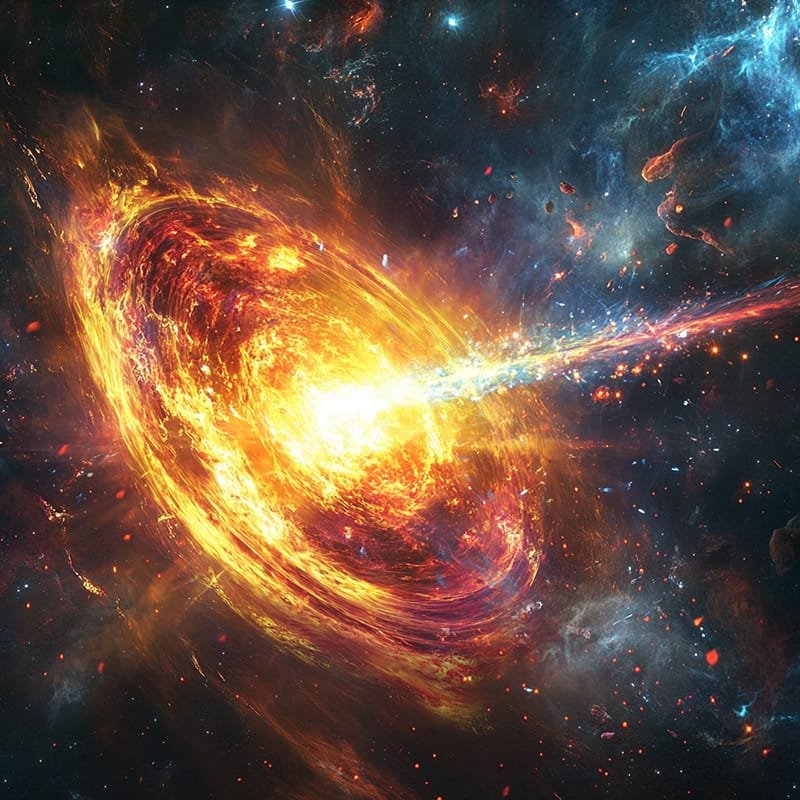Discover the hottest phenomena in the universe! Explore quasars, supernovae, and the intriguing Planck temperature. Click to learn more!
The Hottest Thing in the Universe: Observations and Limits
When it comes to the universe, temperatures can reach unimaginable extremes. From the blazing heat of cosmic events to the theoretical maximum temperature defined by physics, the hottest things in the universe offer a fascinating glimpse into the extremes of nature. In this post, we’ll dive deep into the hottest observed phenomena in the universe and explore the theoretical limits of temperature, including the mysterious Planck temperature.
Key Takeaways
- The hottest observed phenomena in the universe include quasars, supernovae, gamma-ray bursts, and neutron star collisions.
- Quasars are among the hottest known objects, with core temperatures reaching 10 trillion Kelvin.
- Theoretical physics defines the Planck temperature, approximately 1.416785 × 10³² Kelvin, as the maximum possible temperature.
- There’s a vast gap between the hottest observed temperatures and the theoretical maximum.
- The early universe, moments after the Big Bang, likely experienced temperatures approaching the Planck limit.
What Is the Hottest Thing in the Universe?

To answer this question, we need to separate observed astronomical phenomena from theoretical physics concepts. Observed phenomena represent actual temperatures measured or estimated in space, while theoretical concepts push the boundaries of what is physically possible.
The Hottest Observed Phenomena in the Universe
1. Quasars and Supermassive Black Holes
Quasars are some of the brightest and hottest objects in the universe. They are powered by supermassive black holes at the centers of distant galaxies. As matter spirals into the black hole, it forms an accretion disk, where intense friction and gravitational forces generate incredible heat.
- The quasar 3C273, one of the most studied quasars, has a core temperature of around 10 trillion Kelvin (10¹³ K).
- These extreme temperatures occur because of the immense energy released when gas and dust are compressed near the event horizon of the black hole.
Quasars are not just hot—they are also some of the most luminous objects in the universe, visible across billions of light-years.
2. Supernovae
A supernova marks the explosive death of a massive star. During this event, the core of the star collapses under its own gravity, releasing an enormous amount of energy.
- At the peak of a supernova, temperatures in the core can reach 100 billion Kelvin (10¹¹ K).
- This heat creates the conditions necessary for the formation of heavy elements, which are then scattered into space during the explosion.
Although supernovae are transient, lasting only a few weeks to months, they represent some of the hottest and most energetic processes observed in the universe.
3. Cosmic Collisions: Neutron Star Mergers
When two neutron stars collide, the resulting event produces extreme temperatures and energy. These collisions are also responsible for creating gravitational waves, ripples in spacetime that have been detected by advanced observatories like LIGO.
- Temperatures during a neutron star collision can reach 800 billion Kelvin (8 × 10¹¹ K).
- The intense heat and pressure during these collisions are also believed to create heavy elements like gold and platinum.
These collisions are rare but provide a dramatic example of how violent and hot the universe can be.
4. Gamma-Ray Bursts (GRBs)
Gamma-ray bursts are the most powerful explosions in the universe, releasing more energy in a few seconds than the Sun will emit in its entire lifetime. GRBs are thought to occur during supernovae or when neutron stars merge.While exact temperature measurements are challenging, GRBs likely produce temperatures that exceed those of typical supernovae, potentially rivaling the heat of neutron star collisions.
- GRBs emit incredibly high-energy radiation, making them some of the most extreme natural phenomena in the cosmos.
5. Human-Made Temperatures: Laboratory Achievements
In laboratory conditions, humans have managed to create incredibly high temperatures using particle accelerators.
- In 2012, scientists at the Large Hadron Collider (LHC) created temperatures of about 4 trillion degrees Celsius (4 × 10¹² K) during experiments involving the collision of heavy ions.
- These temperatures are far hotter than the core of the Sun, which is only about 15 million Kelvin (1.5 × 10⁷ K).
While these experiments are impressive, they pale in comparison to the hottest cosmic events and the theoretical maximum temperature.
Theoretical Maximum Temperature: The Planck Temperature

What Is the Planck Temperature?
The Planck temperature is the upper limit of temperature as defined by theoretical physics. It is approximately 1.416785 × 10³² Kelvin.
- At this temperature, the energy density becomes so high that quantum gravitational effects dominate.
- The Planck temperature represents a point where the current laws of physics break down, as no theory fully integrates quantum mechanics with general relativity.
Why Can’t Anything Be Hotter?
At temperatures approaching the Planck limit:
- Particles gain so much energy that they could theoretically form micro black holes.
- The structure of spacetime itself becomes distorted, and classical concepts like temperature lose their meaning.
The Planck temperature is thought to have existed during the first moments after the Big Bang, before the universe cooled and expanded.
Comparing Observed Temperatures to the Planck Temperature
There’s an enormous gap between the hottest observed temperatures and the theoretical Planck temperature:
| Phenomenon | Temperature Estimate |
|---|---|
| Human-made (LHC) | 4 trillion Kelvin (4 × 10¹² K) |
| Quasars | 10 trillion Kelvin (10¹³ K) |
| Neutron Star Collisions | 800 billion Kelvin (8 × 10¹¹ K) |
| Supernovae | 100 billion Kelvin (10¹¹ K) |
| Planck Temperature | 1.416785 × 10³² Kelvin |
While quasars and neutron star collisions represent the hottest observed phenomena, they are still 20 orders of magnitude cooler than the Planck temperature!
Early Universe: A Glimpse at Extreme Heat
The early universe, moments after the Big Bang, likely experienced temperatures close to the Planck temperature. During this time:
- The universe was a dense, hot plasma of fundamental particles.
- Temperatures were so high that matter as we know it could not exist.
As the universe expanded, it began to cool, eventually forming protons, neutrons, and atoms. Today, the universe’s background temperature is a frigid 2.7 Kelvin, as measured by the Cosmic Microwave Background (CMB).
Final Thoughts, What Is the Hottest Thing in the Universe?
The hottest observed thing in the universe is likely a quasar, such as 3C273, with core temperatures reaching 10 trillion Kelvin. Other extreme events, like neutron star collisions, also produce extraordinary heat.However, the theoretical hottest temperature is the Planck temperature (1.416785 × 10³² Kelvin). This represents a boundary where the laws of physics break down, and our understanding of temperature reaches its limit.Understanding these extreme temperatures helps scientists explore the fundamental nature of the universe, from the violent processes of cosmic evolution to the mysterious conditions of the early universe. Whether it’s through observational astronomy or theoretical physics, the quest to understand the hottest things in the universe continues to push the boundaries of human knowledge.































